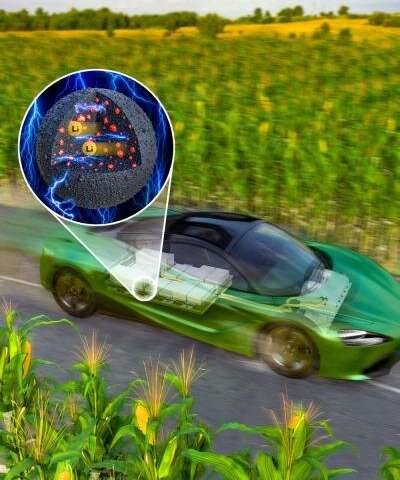
Posted on 03/20/2020 7:55:47 AM PDT by Red Badger

KIST researchers developed cathode material of carbon-silicon complex by simply mixing and heating silicon mixed with oil with green ingredients corn and sweet potato starch. If batteries made of this material are installed in electric vehicles, the driving range will more than double. Credit: Korea Institute of Science and Technology (KIST)
_______________________________________________________________________________________
Dr. Hun-Gi Jung and his research team at the Center for Energy Storage Research of the Korea Institute of Science and Technology (KIST, President Lee Byung Gwon) have announced the development of silicon anode materials that can increase battery capacity four-fold in comparison to graphite anode materials and enable rapid charging to more than 80% capacity in only five minutes. When applied to batteries for electric vehicles, the new materials are expected to more than double their driving range.
The batteries currently installed in mass-produced electric vehicles use graphite anode materials, but their low capacity contributes to electric vehicles' having a shorter driving range than vehicles with internal combustion engines. Consequently, silicon, with an energy storage capacity 10-times greater than graphite, has drawn attention as a next-generation anode material for the development of long-range electric vehicles. However, silicon materials have not yet been commercialized because their volume expands rapidly and storage capacity decreases significantly during charge and discharge cycles, which limits commercialization. A number of methods have been suggested for enhancing the stability of silicon as an anode material, but the cost and complexity of these methods have prevented silicon from replacing graphite.
To enhance the stability of silicon, Dr. Jung and his team focused on using materials that are common in our everyday lives, such as water, oil, and starch. They dissolved starch and silicon in water and oil, respectively, and then mixed and heated them in order to produce carbon-silicon composites. A simple thermal process used for frying food was employed to firmly fix the carbon and silicon, preventing the silicon anode materials from expanding during charge and discharge cycles.
The composite materials developed by the research team demonstrated a capacity four-times greater than that of graphite anode materials (360mAh/g - 1,530mAh/g) and stable capacity retention over 500 cycles. It was also found that the materials enable batteries to charge to more than 80% capacity in only five minutes. Carbon spheres prevent the usual volume expansion of silicon, thereby enhancing the stability of silicon materials. Also, the use of highly conductive carbon and the rearrangement of the silicon structure resulted in a high output.
"We were able to develop carbon-silicon composite materials using common, everyday materials and simple mixing and thermal processes with no reactors," said Dr. Jung, the lead researcher of the KIST team. He continued, "The simple processes we adopted and the composites with excellent properties that we developed are highly likely to be commercialized and mass-produced. The composites could be applied to lithium-ion batteries for electric vehicles and energy storage systems (ESSs)."
The research results were published in the most recent issue of Nano Letters.
More information: Hyun Jung Kwon et al, Nano/Microstructured Silicon–Carbon Hybrid Composite Particles Fabricated with Corn Starch Biowaste as Anode Materials for Li-Ion Batteries, Nano Letters (2019). DOI: 10.1021/acs.nanolett.9b04395 Journal information: Nano Letters
A wok?.....................
KIST researchers developed cathode material of carbon-silicon complex by simply mixing and heating silicon mixed with oil with green ingredients corn and sweet potato starch. If batteries made of this material are installed in electric vehicles, the driving range will more than double.
...
Let us know when that happens, which will be never.
Well, it’s good to know you can eat it when the time comes...................
Interesting, but I would imagine that thermal management might be an issue. Great to go twice as far, but if you’re on fire, not that pleasant a ride.
“They dissolved starch and silicon in water and oil...”
Heh.
‘Spillway’ for electrons could keep lithium metal batteries from catching fire:
https://phys.org/news/2020-03-spillway-electrons-lithium-metal-batteries.html
Nanoengineers at the University of California San Diego developed a safety feature that prevents lithium metal batteries from rapidly heating up and catching fire in case of an internal short circuit.
The team made a clever tweak to the part of the battery called the separator, which serves as a barrier between the anode and cathode, so that it slows down the flow of energy (and thus heat) that builds up inside the battery when it short circuits.
The researchers, led by UC San Diego nanoengineering professor Ping Liu and his Ph.D. student Matthew Gonzalez, detail their work in a paper published in Advanced Materials.
“We’re not trying to stop battery failure from happening. We’re making it much safer so that when it does fail, the battery doesn’t catastrophically catch on fire or explode,” said Gonzalez, who is the paper’s first author.
And then stir fried it....................NO MSG...................
Very interesting.
Thanks!
— Gertrude Stein
Given a range of 80 miles I’ll be able to make over 14000 trips up and down my driveway while sheltering in place.
Luxury vehicle
Model: 2020 Tesla Model S
MSRP: From $79,990
Range: 390 mi battery-only
Dimensions: 196″ L x 77″ W x 57″ H
MPGe: 115 city / 107 highway
Tire size: P245/45R19
Engine: Electric
Oh, not for the golf course... nevermind.
Depends on how well you play..................
Dr Jung is full of crap
Wouldn’t that be Dr. Dung?...................
Image a battery made from Wheaties! Four times the output!
Will it take twice as long to charge too, and will we have to use produce twice as much petroleum based electrical generation?
Disclaimer: Opinions posted on Free Republic are those of the individual posters and do not necessarily represent the opinion of Free Republic or its management. All materials posted herein are protected by copyright law and the exemption for fair use of copyrighted works.